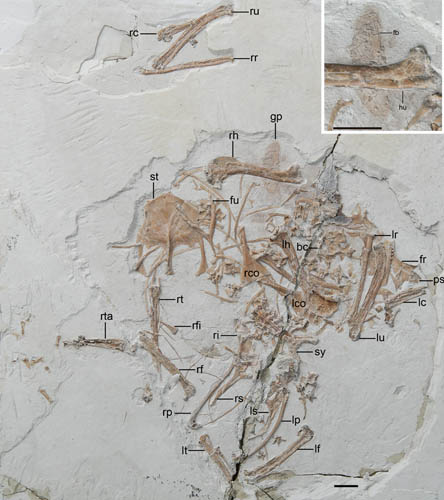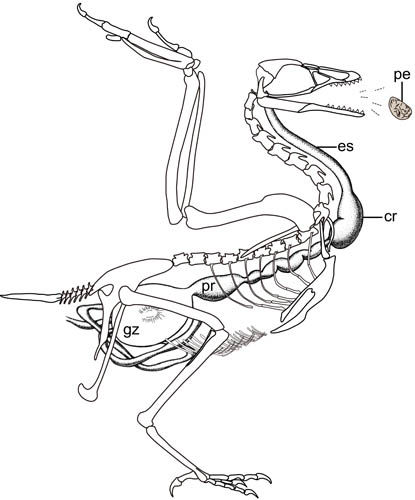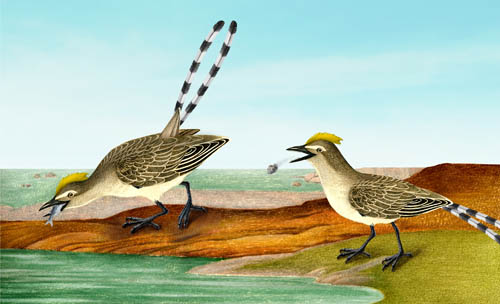Fish-Eating Enantiornithine Bird Provides Evidence of Modern Avian Digestive Features
Enantiornithes are the most successful clade of Mesozoic birds, representing the sister group of the Ornithuromorpha, which gave rise to living birds. Nevertheless, the feeding habits of enantiornithines have remained unknown because of a lack of fossil evidence. In contrast, exceptionally preserved fossils reveal that derived avian features were present in the digestive systems of some non-enantiornithine birds with ages exceeding 125 million years.
In paper published online April 28 in the journal of Current Biology (26), Drs. WANG Min, ZHOU Zhonghe and Corwin Sullivan, Institute of Vertebrate Paleontology and Paleoanthropology (IVPP ), Chinese Academy of Sciences, reported a new piscivorous enantiornithine from the Early Cretaceous Jehol Biota of China. This specimen preserves a gastric pellet that includes fish bones, and is the oldest birds’ pellet dating back 120 million years ago. This finding provides evidence of modern avian digestive features in the Early Cretaceous enantiornithine birds.
The new enantiornithine bird (IVPP V22582) was collected from the Lower Cretaceous Jiufotang Formation near Dapingfang Town, Chaoyang Country, Liaoning Province, northeastern China. It was assigned to Enantiornithes on a combination of characteristics including the coracoid lacking a procoracoid process and having a convex lateral margin. A detailed morphological study of the new specimen is in preparation and will be presented in a separated paper.
Modern birds differ from their theropod ancestors in lacking teeth and heavily constructed bony jaws, having evolved a lightly built beak and a specialized digestive system capable of processing unmasticated food.
Researchers observed that a spindle-shaped cluster of fish bones, with long and short axes measuring 22.6 mm and 7.1 mm respectively, is overlapped by the right humerus. The bones include vertebrae, neural spines, and unidentifiable fragments. They are most likely attributable to the teleost Lycoptera, the most abundant fish at this locality.
Researchers believed that the spindle-shaped structure was a pellet regurgitated by the bird shortly before, or even at, the time of death. This conclusion is reinforced by the sharp boundary between the brown matrix enclosing the densely concentrated fish bones and the white host matrix of the slab, which implies that the spindle-shaped structure was cohesive and well defined like the pellets of modern birds. Because of these characteristics and the lack of fish bones elsewhere on the slab, the aggregation is unlikely to be a preservational artifact.
This new enantiornithine, like many modern piscivores and raptors, seems to have swallowed its prey whole and regurgitated indigestible materials such as bones, invertebrate exoskeletons, scales, and feathers. This finding provides the first evidence that some enantiornithine birds were piscivorous and that distinctive features of modern avian digestive system were well established in some Early Cretaceous birds.
“This fossil represents the oldest unambiguous record of an avian gastric pellet and the only such record from the Mesozoic”, said lead author WANG Min of the IVPP, “The pellet points to a fish diet and suggests that the alimentary tract of the new enantiornithine resembled that of extant avians in having efficient antiperistalsis and a two-chambered stomach with a muscular gizzard capable of compacting indigestible matter into a cohesive pellet.”
“The inferred occurrence of these advanced features in an enantiornithine implies that they were widespread in Cretaceous birds and likely facilitated dietary diversification within both Enantiornithes and Ornithuromorpha”, said ZHOU Zhonghe, co-correspoding author of the IVPP.
This work is funded by the National Natural Science Foundation of China, the Youth Innovation Promotion Association of CAS, and the National Basic Research Program of China (973 Program).

Fig.1. Enantiornithine bird (IVPP V22582), preserving a pellet containing fish bones (Image by WANG Min).

Fig.2 A Sketch reconstruction of the fish-eating enantiornithine bird (Image by WANG Min and SHI Aijuan).

Fig.3 Life reconstruction of the fish-eating enantiornithine bird (Image by SHI Aijuan).
Contact:
WANG Min
Email:wangmin@ivpp.ac.cn
Download attachments: